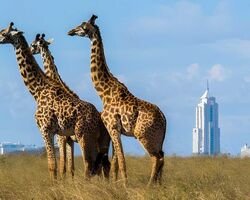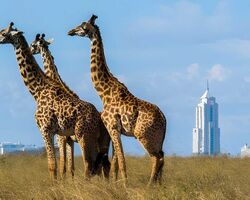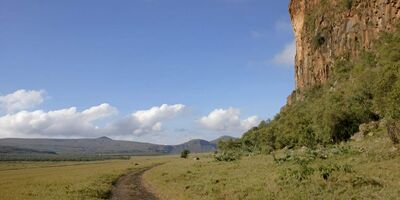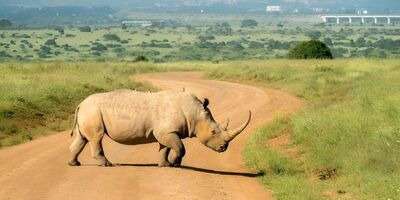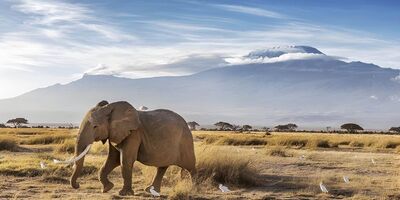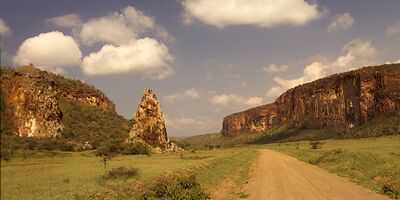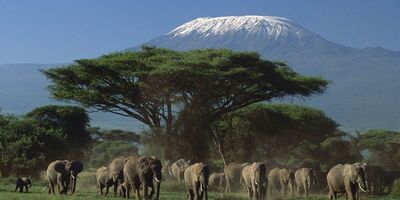- Sheldrick Wildlife Trust (Elephant Nursery) Information
- Top Things To Do in Sheldrick Wildlife Trust (Elephant Nursery)
- View Places on Sheldrick Wildlife Trust (Elephant Nursery) Map
- Places to Visit near Sheldrick Wildlife Trust (Elephant Nursery)
- Sheldrick Wildlife Trust (Elephant Nursery) Getaways
- Sheldrick Wildlife Trust (Elephant Nursery) Tours & Things To Do
Sheldrick Wildlife Trust (Elephant Nursery) , Nairobi
About Sheldrick Wildlife Trust (Elephant Nursery)
The David Sheldrick Wildlife Trust (DSWT), now commonly known as the Sheldrick Wildlife Trust (SWT), is one of the most renowned conservation organizations in Africa. Founded in 1977 by Dr. Dame Daphne Sheldrick in memory of her late husband, David Sheldrick, a pioneer in Kenyan wildlife conservation, the trust has become famous worldwide for its efforts in rescuing, rehabilitating, and reintroducing orphaned elephants into the wild.
Located on the outskirts of Nairobi National Park, the trust provides a unique opportunity for visitors to engage closely with baby elephants, understand the challenges of wildlife conservation, and contribute to the cause. The experience at the Sheldrick Wildlife Trust is not just about seeing elephants; it’s about connecting with them and learning about the critical role they play in Kenya's ecosystem.
Getting to the David Sheldrick Wildlife Trust
The Sheldrick Wildlife Trust is situated just a short drive from Nairobi’s city center, making it easily accessible for both local and international visitors.
By Car: The trust is located approximately 17 kilometers from the Nairobi Central Business. Parking available at the entrance. Driving is one of the most convenient ways to visit the trust, especially if you plan to explore other nearby attractions such as Nairobi National Park or the Giraffe Centre.
By Public Transport: Although public transport is available, it may not be the most comfortable or direct option for reaching the trust. Matatus (public minibuses) operate routes along Langata Road, but you may need to take a taxi or a ride-sharing service from the nearest drop-off point to reach the trust.
By Taxi or Ride-Sharing Services: Taxis and ride-sharing services like Uber and Bolt are readily available in Nairobi. These services offer a convenient and comfortable way to reach the trust directly from your hotel or any other location in the city.
Tour Packages: Many tour operators offer packages that include a visit to the Sheldrick Wildlife Trust as part of a broader itinerary. These packages often include transportation, guided tours, and visits to other attractions like the Giraffe Centre or Nairobi National Park, making them a great option for first-time visitors.
Best Time to Visit the David Sheldrick Wildlife Trust
The Sheldrick Wildlife Trust is open to visitors for a special public viewing session every day, except on December 25th, from 11:00 AM to 12:00 PM. This is the only time when the baby elephants are brought out to interact with visitors, so planning your visit around this time is essential.
Weather Considerations: Nairobi enjoys a moderate climate throughout the year, but the best time to visit the trust aligns with the city's dry seasons, from July to October and January to February. During these months,
the rainy seasons (March to May and October to December), visiting the Sheldrick Wildlife Trust can still be a rewarding experience. The rain doesn’t significantly affect the baby elephants’ routines, and the lush surroundings can make for beautiful scenery.
Crowd Considerations: Since the trust is only open for one hour daily, it can get quite crowded, especially during peak tourist seasons (June to September and December to January). To get the best experience, it’s advisable to arrive early, ideally around 10:30 AM, to secure a good viewing spot.
What to Expect During Your Visit
1. The Public Viewing Session During the one-hour public viewing session, you’ll have the opportunity to watch the baby elephants as they are fed, play in the mud, and interact with their keepers. This session is not just a chance to see elephants up close, but also to learn about the work the Sheldrick Wildlife Trust does in rescuing and rehabilitating orphaned elephants.
The keepers provide informative talks about each elephant’s background, the reasons they were orphaned, and the rehabilitation process. These talks offer valuable insights into the challenges of wildlife conservation in Kenya, including the threats posed by poaching, habitat loss, and human-wildlife conflict.
2. Up-Close Interaction One of the highlights of visiting the Sheldrick Wildlife Trust is the opportunity to interact with the baby elephants. While visitors are not allowed to touch the elephants, the close proximity allows for an intimate experience where you can observe their playful behavior, hear their trumpeting, and even see them use their trunks to splash water or mud.
3. Adopting an Elephant The Sheldrick Wildlife Trust offers an adoption program, where visitors can adopt one of the orphaned elephants. For a minimum annual donation, you can support the care and rehabilitation of an elephant and receive regular updates on its progress. Adoption comes with privileges like access to the trust’s exclusive visiting hours in the evening, where adopters can witness the elephants returning to their stables and have more personalized interactions with the keepers.
4. Educational Talks Throughout the public viewing session, the keepers and conservationists share detailed information about the trust’s conservation efforts, the plight of elephants in the wild, and the broader issues of wildlife protection in Kenya. This educational component makes the visit both enlightening and emotionally moving, as you gain a deeper understanding of the impact of human activity on wildlife.
5. The Nursery The Sheldrick Wildlife Trust is home to a nursery where the youngest and most vulnerable elephants are cared for. While the nursery itself is not open to the public during the general visiting hours, adopters who visit during the evening sessions may have the chance to see these baby elephants being fed and settled for the night.
Wildlife Conservation at the Sheldrick Wildlife Trust
The Sheldrick Wildlife Trust is not just a tourist attraction; it is a vital player in Kenya’s conservation efforts. The trust’s mission extends beyond the rescue and rehabilitation of elephants. It also includes anti-poaching operations, community outreach programs, and habitat preservation initiatives.
Anti-Poaching Efforts: The trust operates several mobile veterinary units and anti-poaching teams across Kenya, working tirelessly to protect wildlife from poachers and treat injured animals in the wild. These efforts have been crucial in reducing the number of elephants killed for their ivory and other wildlife targeted by poachers.
Community Outreach: The Sheldrick Wildlife Trust actively engages with local communities to promote wildlife conservation. Through educational programs, the trust aims to raise awareness about the importance of protecting Kenya’s natural heritage and reduce human-wildlife conflict.
Habitat Preservation: The trust also focuses on preserving and restoring critical habitats that are essential for the survival of wildlife. By working with the Kenya Wildlife Service and other partners, the Sheldrick Wildlife Trust plays a significant role in safeguarding Kenya’s national parks and wildlife corridors.
Visitor Tips for the David Sheldrick Wildlife Trust
1. Book in Advance: Given the limited visiting hours and the popularity of the trust, it’s advisable to book your visit in advance, especially during peak tourist seasons. Check the trust’s official website for the latest information on bookings and entry fees.
2. Dress Appropriately: Nairobi can get quite warm, so wear light, comfortable clothing. A hat, sunglasses, and sunscreen are recommended to protect against the sun. If you’re visiting during the rainy season, consider bringing a light rain jacket.
3. Bring a Camera: Photography is allowed, and the trust is a great place to capture memorable moments with the elephants. However, be respectful of the animals and the rules regarding flash photography.
4. Support the Cause: Consider adopting an elephant or making a donation to support the Sheldrick Wildlife Trust’s conservation efforts. Every contribution helps ensure the survival of these magnificent creatures.
5. Respect the Animals: While it’s tempting to get as close as possible to the elephants, it’s important to follow the keepers’ instructions and maintain a safe and respectful distance. These are wild animals, and their well-being should always come first.
The David Sheldrick Wildlife Trust offers a unique and profoundly moving experience for anyone interested in wildlife conservation. A visit to this sanctuary is not just about seeing elephants up close; it’s about understanding the challenges they face in the wild and the tireless efforts being made to protect them. Whether you’re a first-time visitor to Nairobi or a seasoned traveler, the Sheldrick Wildlife Trust is a must-see destination that will leave you with a lasting appreciation for Kenya’s natural heritage and the importance of conservation.
Supporting the trust by visiting, adopting an elephant, or making a donation helps ensure that these orphaned elephants can one day return to the wild, where they belong. Your visit to the David Sheldrick Wildlife Trust is more than just an attraction—it’s a contribution to the future of Africa’s wildlife.
2 Tours & Activities in Sheldrick Wildlife Trust (Elephant Nursery)
See All Sheldrick Wildlife Trust (Elephant Nursery) ToursLocation & Places to Visit on Sheldrick Wildlife Trust (Elephant Nursery) Map
View destinations and attractions nearby Sheldrick Wildlife Trust (Elephant Nursery), on an interactive map.
Freedom to make your own trip!
What you want, when you want and how you want.



